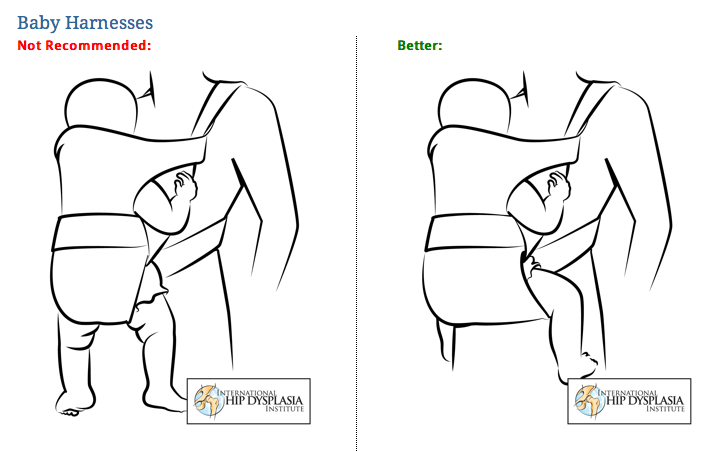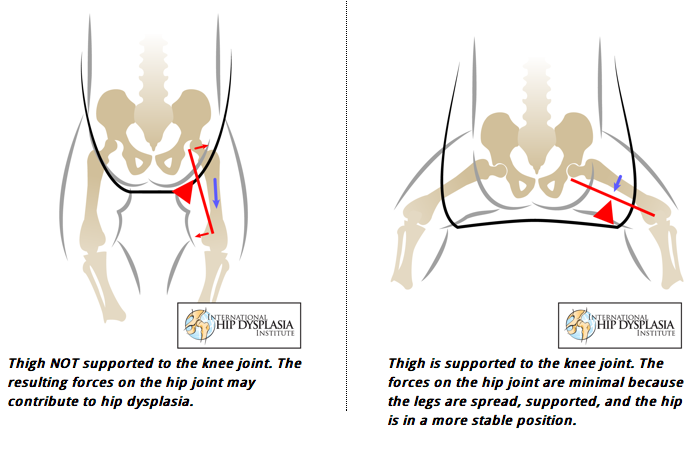
 When writing a review of a [amazon_link id=”B000CSBP86″ target=”_blank” ]Baby Bjorn infant carrier[/amazon_link], the carrier I used most for baby wearing my infants, a reader commented on the concern of hip dysplasia. I had never even considered this a risk with any baby wearing device, and I was seeking my own comfort and the baby’s contentment when finding what worked best for us.
When writing a review of a [amazon_link id=”B000CSBP86″ target=”_blank” ]Baby Bjorn infant carrier[/amazon_link], the carrier I used most for baby wearing my infants, a reader commented on the concern of hip dysplasia. I had never even considered this a risk with any baby wearing device, and I was seeking my own comfort and the baby’s contentment when finding what worked best for us.
It turns out, it is not just baby carriers that increase the risk of hip dysplasia in infants, but it is also car seats, slings, walkers, bouncers, seats, et cetera.
My midwife posted the following article on Facebook from the International Hip Dysplasia Institute (IHDI):
Education Statement: The IHDI recommends healthy hip positioning for all babies to encourage normal hip development. Within the womb, a baby spends a long time tucked in the fetal position, in which both hips and knees are bent or flexed.
Baby in normal (fetal) womb position.After birth, it takes several months for the joints to stretch out naturally. Babies that have been in the breech (bottom first) position may need even more time to stretch out naturally. The hip joint is a ball and socket joint. During the first few months of life the ball is more likely to be loose within the socket because babies are naturally flexible and because the edges of the socket are made of soft cartilage like the cartilage in the ear. If the hips are forced into a stretched-out position too early, the ball is at risk of permanently deforming the edges of the cup shaped socket (hip dysplasia) or gradually slipping out of the socket altogether (hip dislocation). Hip dysplasia or dislocation in babies is not painful so this may go undetected until walking age and may also result in painful arthritis during adulthood. The risk of hip dysplasia or dislocation is greatest in the first few months of life. By six months of age, most babies have nearly doubled in size, the hips are more developed and the ligaments are stronger, so are less susceptible to developing hip dysplasia.
The most unhealthy position for the hips during infancy is when the legs are held in extension with the hips and knees straight and the legs brought together, which is the opposite of the fetal position. The risk to the hips is greater when this unhealthy position is maintained for a long time. Healthy hip positioning avoids positions that may cause or contribute to development of hip dysplasia or dislocation. The healthiest position for the hips is for the hips to fall or spread (naturally) apart to the side, with the thighs supported and the hips and knees bent. This position has been called the jockey position, straddle position, frog position or human position. Free movement of the hips without forcing them together promotes natural hip development.
Some carriers, car seats, slings, etc. place baby’s hips and legs in unnatural positions for their age. The extended time period children spend in these devices can cause injury.
I am still not convinced the Baby Bjorn is harmful unless children are place in it wrong or spend too much time in it. Viewing the diagrams from IHDI are helpful in selecting and placing babies in carrying, pushing, or holding paraphernalia. Remember, strollers and car seats are also potential hip and leg stressors.



Jennifer, this is interesting. I have heard some parents talk about the Baby Bjorn carrier putting unnecessary pressure on areas of the baby’s legs in the front (baby facing out) position. It looks like the above illustration shows this is possible. One thing I do know from personal experience is that sling carriers and wrap carriers allow for the very young baby’s legs to ball up and curl up, instead of be stretched out and I have seen many newborns carried this way and their legs do seem to fit well in the soft carriers like this. As the information says above, the risk of hip dysplasia is obviously less of a problem after 6 months of age when a baby’s are grown and stretched out more, which is the time, in my experience, when a baby would no longer be as comfortable carried in the soft carriers, slings or wraps with their legs curled up.
I could never get the hang of slings. I tried several different ones. I was always concerned my baby’s neck was in a weird position, and I felt lopsided. I never had an Ergo, which I hear are really good.
Thank you so much for highlighting this. My daughter had hip dysplasia when she was born and we were very fortunate that our pediatrician caught it early. After our experience, I have always been cognizant of her hip positioning and often wondered about carseats and carriers.
This has been a known issue and points of debate for many years. It’s strange that there hasn’t been more focus on this matter a long time ago. Combi (a Japanese parenting company) make an awesome baby carrier which carriers the baby in a cradling position until the baby is 6 months old and then when baby is bigger and stronger allows upright carriers. It seems yet again the Japanese are way ahead of the game.
You should get a better carseat so that legs can be spread apart evenly.